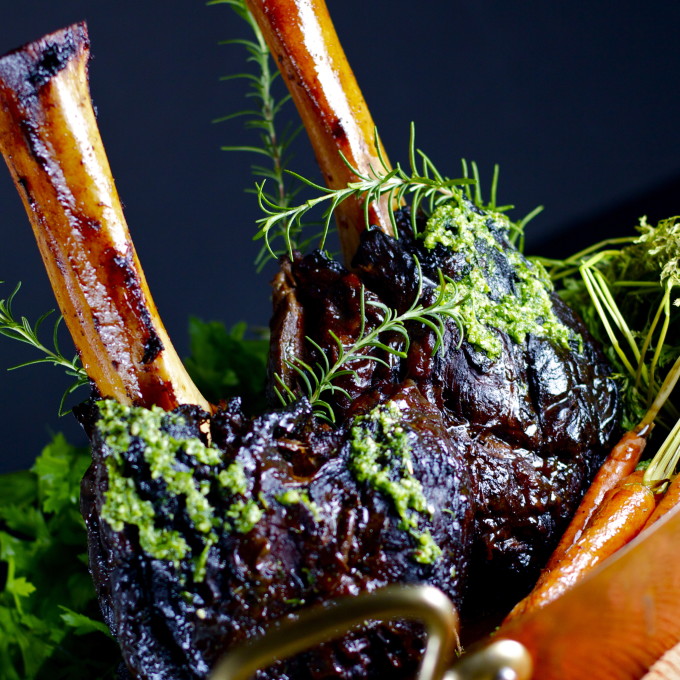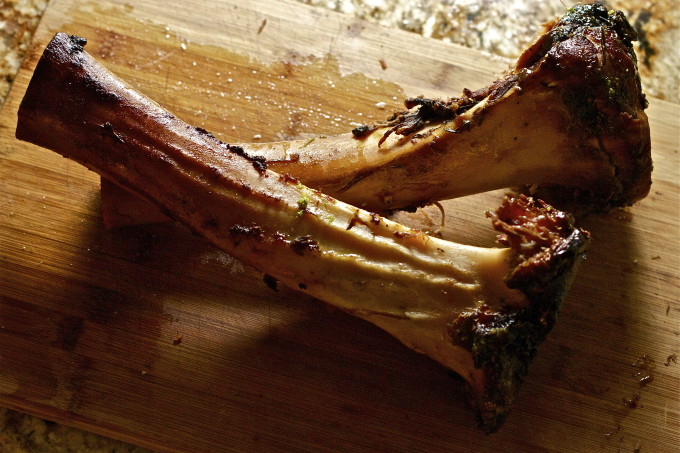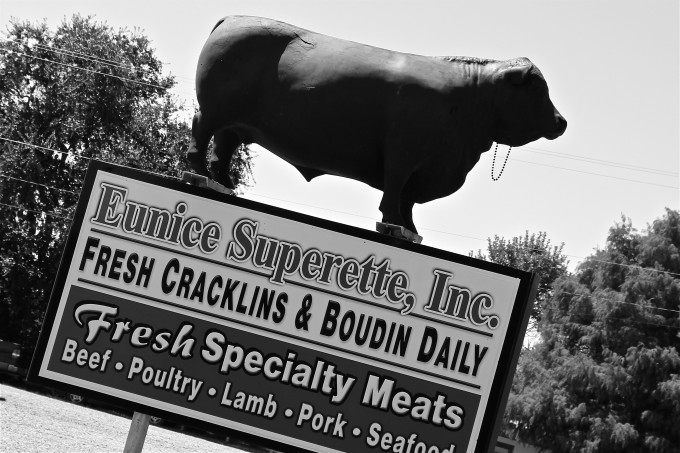Let’s cut to the meat of this story–whole sectional cuts of beef are irresistible to me. They harken back to pioneer days and more rustic farm-style butchering techniques. But beef shanks are rarely seen whole in the supermarket. My guess is that retailers fear that timid customers will panic and run screaming from the meat counter at the site of such a gargantuan chunk of steer. But, if you really analyze it, the meat off of a whole shank portion of beef is no bigger than most pot roast cuts with one exception–the bone. With my Braised Beef Shanks recipe, I aim to reintroduce you to this tasty cut.

Whole bone-in beef shanks are a thing of beauty in this Braised Beef Shanks recipe. (All photos credit; George Graham)
It is true that the protruding shank bone is a gasp-inducing and somewhat scary sight for most shoppers unaccustomed to a butcher’s back room. In addition, it goes without saying that most folks don’t want to pay the added price-per-pound cost of the bones. That’s why shanks are usually portioned into the more manageable 2-inch-thick, osso bucco-type cut. Not for me. I’ll take the leg of the beast every time.

Beef shank bones.
Make friends with your local butcher and he can find this cut for your next Braised Beef Shanks recipe. Right here in South Louisiana, my go-to source for any custom cuts is Eunice Superette in Eunice. Over fifty years ago, Jerome Moore opened up the “Superette” as it is now known. What was a typical Cajun prairie grocery store is now the state’s largest meat processing facility. Each morning, trailers full of livestock line up in the rear of the store destined for the “kill floor” and on to slaughter, processing and shipping. In the front retail center your senses are overwhelmed with the flavors and aromas of a tamer sort–smoked sausage, fresh boudin, and an endless array of meats. It is a meat lover’s nirvana. Calling ahead (get the contact info on the Faces and Places page) for a custom order is appropriate and a good idea for a quick in and out pick-up for the beef for your Braised Beef Shanks.

Any way you cut it, Eunice Superette is the place to go for rural Cajun meats and Cajun recipe ingredients like my Braised Beef Shanks recipe.
The point of roasting a whole shank is twofold: The bone imparts enormous flavor, and the slow braise breaks down the collagen inside. The shank is the weight-bearing leg portion of the cow that is all muscle and very little fat. An 8-hour cooking time in flavorful braising liquids reduces the connective tissue into sticky, sweet meat that is almost impossible from leaner, quickly grilled cuts, and the luscious marrow is a hidden treat inside the bones.
For my Braised Beef Shanks recipe, I braise my shanks in two stages. The day before, I slow cook them in beer and refrigerate them in the braising liquid overnight. The day I plan to serve my Braised Beef Shanks, I put them on in the morning and add a bottle of red wine to the liquid along with chicken broth. Low and slow is the only way to reduce the sinewy tissue clinging to the bone. After a few hours, the meat is fork-tender and gelatinous–literally falling off the bone. And the long shank is exposed for a most dramatic presentation. Adding a bit of Port wine to the reduced liquid creates a sauce that is rich and beefy.
Taking a cue from the gaucho culture of Argentina, I like to serve these magnificent Braised Beef Shanks with a chimichurri-like pesto sauce. Instead of typical basil pesto, I use parsley as my dominant herb along with rosemary and garlic. Pecans add a bit of crunch and a grated Mexican cotija is a salty replacement for the typical Parmesan. With just the right balance of extra virgin olive oil, I think you will enjoy the fresh change of this new pesto version.
- 3 cups firmly-packed flat-leaf parsley
- 2 garlic cloves, peeled
- ½ cup toasted pecans
- 1 teaspoon kosher salt
- 1 cup extra virgin olive oil
- 2 tablespoons freshly grated Mexican cotija cheese or Parmesan
- 2 large (4-pound) bone-in beef shanks
- Kosher salt and freshly ground black pepper
- 2 (12-ounce) bottles beer
- 4 cups chicken stock
- 2 whole onions, peeled and quartered
- 4 large carrots, peeled and ends removed
- 2 whole heads garlic
- 4 ribs of celery
- 6 sprigs fresh rosemary, divided
- 2 bay leaves
- 1 (750ml) bottle dry red wine
- ½ cup Port wine
- 4 tablespoons cornstarch
- 4 tablespoons cold water
- 2 tablespoons unsalted butter
- In the container of a blender, add the parsley, garlic, pecans, salt, and cheese. Slowly drizzle the oil and turn the blender to the lowest speed. Gradually increase the speed and continue adding oil just until the ingredients are pulverized, but before it becomes a paste. Stop the blender and stir in the cheese. Using a rubber spatula, remove the pesto to a bowl, cover and chill.
- Preheat the oven to 350ºF.
- Sprinkle the beef shanks with salt and pepper, making sure to coat all sides. In a large cast-iron dutch oven with a heavy lid, add the shanks. Pour in the beer and 2 cups of the chicken stock, and place all of the vegetables in the pot. Add 4 rosemary sprigs and the bay leaves. Place in the oven for 4 hours, and turn the meat over after 2 hours.
- Once the meat has cooked the full 4 hours, remove from the oven and let cool to room temperature. Move the shanks and the liquid to the refrigerator overnight.
- The next day, preheat the oven to 350ºF. Remove the meat and liquids from the refrigerator, and skim the fat from the top of the liquids and discard. Remove the vegetables and herbs. Add the red wine and additional 2 cups of chicken stock. Place the meat and liquid back into the oven for 4 hours, turning the meat once at the half-way point. Remove from the oven and check for doneness. The meat should be fork tender but still clinging to the bone. If needed, return to the oven for additional cooking.
- Remove the meat from the oven and drain off all the braising liquid into a saucepan. Wrap the meat in foil and keep warm.
- Over high heat, bring the liquids to a boil and add the Port wine. Turn down the heat to a simmer and cook the liquids until it reduces by half. Taste the sauce and add salt and pepper if necessary.
- Make a slurry by combining the cornstarch and water in a small bowl. Stir until dissolved and then add to the sauce. Turn the heat to high and let it come to a boil. Reduce to a simmer and stir until the sauce thickens to coat the back of a spoon. Add butter and stir until dissolved into the sauce. Remove from the heat and keep warm until serving.
- For serving, bring the meat to the table in the pan and pour over the sauce. Garnish with the remaining rosemary sprigs and spoon over some of the pesto. Serve portions of the meat with roasted carrots and mashed potatoes along with a good bottle of red wine. Make sure to spoon the marrow from the bones onto slices of crusty French bread along with a squeeze of the roasted garlic.

Serve the Braised Beef Shanks with mashed potatoes and roasted carrots.
YOUR SEAT AT THE TABLE: If you like this Cajun cooking story and Cajun recipe then accept my personal invitation to subscribe by entering your email at the bottom or top right of this page. It’s quick and painless. You will receive an email alert and be the first to see when new Cajun cooking stories and Cajun recipes are added. Thanks, George.
My shanks are cut in the 2 in pieces. Should I make a change in the amount of liquid? How high up on the meat should it come?
Can’t wait to make this!
Hey Lisa,
That is a very good point. The cut of your shanks and the size of your cooking vessel will change the amount of liquid (beer + stock) that you will need. You do not want to cover the meat and boil it. You want to braise the meat with much of the surface exposed, so I urge you not to come more than halfway up the side of the meat with the liquid. During cooking, check periodically to see that you still have enough liquid in the pot. Thanks to you, I added this notation to the recipe. Best, George
Thanks for the great recipe. I will start making this on Thursday to serve at a dinner party on Friday. I’ll let you know how it goes. Cheers!
Heather – Glad you are following Acadiana Table, and I can’t wait to hear how your dinner party goes. Shanks for the comment (couldn’t help the pun!). Best to you.
LOL! Good pun, George! I had one big shank, almost 8 pounds! It was absolutely gorgeous. Everyone was hugely impressed with your recipe, and said they’ll be trying it, too. So, you’ve got six new fans in Ottawa, Ontario. We’re all looking forward to following your blog and trying more of your recipes. Many thanks! 10 stars!
Hey Heather- Wow, an 8-pound shank is impressive! So glad everyone loved the recipe, and I can’t wait to hear more of your cooking adventures in Ontario. All the best.
Hi George, We are trying this recipe for a Halloween Feast we are having this weekend. We hope the “bone-in” will be frightful! Do you have a recipe for your mashed potatoes you can share? Thank you!
Hey Allison- If you find the large beef shanks, I guarantee a few gasps from your guests. As for the mashed potatoes, I like to keep it simple: peel your Idaho potatoes, boiled them until tender, lots of cream and butter, and a bit of salt and pepper. All the best, and shanks for the comment.
Do you trim the fat and silver skin before cooking? I have 2 beautiful shanks just waiting to go in the oven!
Tess- Yes, but do not trim too much fat off. In my world, fat equals flavor. The long cooking time will render much of it away. All the best.
Served this tonight, one of our guests said it was the one of the best meals they’ve ever had. It was really delicious, paired well with my husband’s homemade beer bread.
Ashley – I love reviews like yours. Thanks for the great comment.
I am so wanting to try this but am not sure where to purchase whole beef shank. Did you specifically request this cut from your butcher? Thank you!
Emily – Yes! Make friends with a butcher, and you will up your game when it comes to cooking great dishes. All the best.
I have my shank in the oven, and I’m excited to serve it tomorrow. The butcher here in San Antonio had two in the butcher’s case. I think I’m going back tomorrow to buy the other. He called it Thor’s hammer beef shank and it also weighed over 8 pounds. You can see (I guess) the knee bones at one end. I’m using Guinness Stout. What a beautiful recipe! Thanks!
Hey Tink- Wow…your “Thor’s Hammer” sounds very impressive and is sure to make an impact with your guests. Cooking time will vary with the size of your shank; be sure to cook it until fall-off-the-bone tender. And I highly suggest you serve it with a horseradish cream in addition to the pesto. Bon Appétit!
I’m not a big fan of pesto, horseradish or anything spicy due to stomach issues is there anything else you suggest for a sauce or just don’t use anything? Otherwise I can’t wait to try this.
Hey Lea – The natural juices will be extremely flavorful, and you can always thicken it with cornstarch and cold water. All the best.
Can the beef shanks be done in a crockpot?
Lea- Technically, yes. But the size of your beef shanks (if they’re like mine) will be challenging to fit in the standard crockpot. Good luck!
I just finished step two with two 4-pound shanks. Both roasts fell off the bone as I attempted to remove them from the pan. I’m planning to shorten my roasting time tomorrow. What do you think? At this point they are tender, but I don’t want to miss the flavors of the second day.
Hey Rebekalu – Size of the shank and oven temperature will dictate how fast the meat cooks. You really can’t overcook this dish, and fall-off-the-bone tender is your goal, just be careful (use two spatulas) in removing it so it doesn’t fall apart. The second day is about the sauce, and I definitely would reduce the cooking time just until the meat is heated through. All the best.
Thank you! I will let you know how it goes.
Due to illness, the dinner was delayed another day. The roast was excellent, loved the pesto and horseradish cream, the gravy was amazing. I did not reduce it by half as I couldn’t bear having less. Maybe I reduced it by a quarter. Love the recipe!